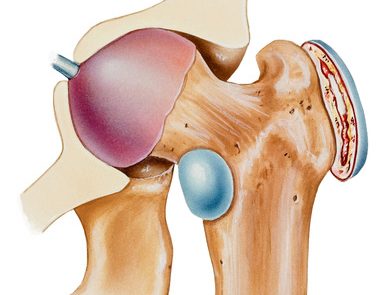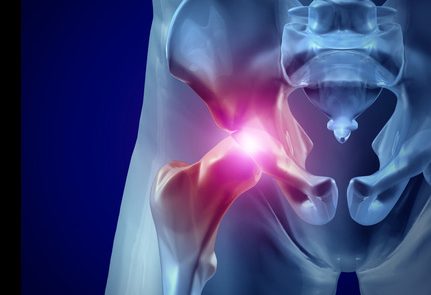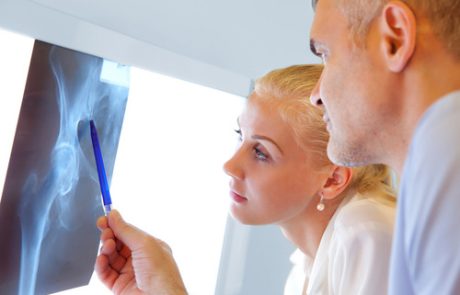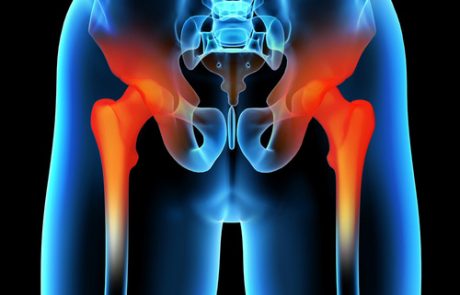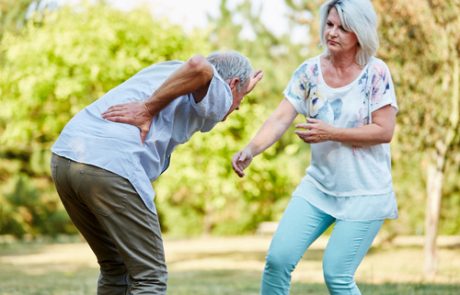
We Use the Latest Technology to Diagnose your Condition
Specialists of the Musculoskeletal System
Keeping your body in motion by providing the best possible orthopedic care is our goal at the Center for Spine and Orthopedics. Our orthopedic surgeons and pain management specialist strive to listen intently to your description of your problem and then use the latest technology to accurately diagnose your condition.
We consider you a partner in your care, and you can help by learning more about common orthopedic conditions to better communicate with your physician. Below is information about the common conditions as described by the American Academy of Orthopedic Surgery.
What are the main symptoms of hip bursitis?
The main symptom of trochanteric bursitis is pain at the point of the hip. The pain usually extends to the outside of the thigh. In the early stages, the pain is usually sharp and intense. Later the pain may become more of an ache and spread across a larger area of the hip.
Typically, the pain is worse at night, when lying on the affected hip and when getting up from a chair after being seated for a while. It also may get worse with prolonged walking, stair climbing or squatting.
A hip fracture is a break in the upper quarter of the femur (thigh) bone. The type of surgery used to treat a hip fracture is primarily based on the bones and soft tissues affected or on the level of the fracture.
The most common symptom of hip osteoarthritis is pain around the hip joint. Pain and stiffness may be worse in the morning or after sitting or resting. Osteoarthritis of the hip can make it hard to do everyday activities, such as bending over to tie a shoe lace, rising from a chair or taking a walk.
Sometimes called “wear-and-tear” arthritis, osteoarthritis is a common condition that many people develop during middle or older age. Most often, it develops in weight-bearing joints, such as the hip.
Because osteoarthritis worsens over time, the sooner you start treatment, the more likely you can reduce its impact on your life. Although there is no cure, many treatment options are available to help you manage pain and stay active.
Osteonecrosis of the hip is a painful condition that occurs when the blood supply to the bone is disrupted. Because bone cells die without a blood supply, osteonecrosis can ultimately lead to destruction of the hip joint and arthritis.
What are the symptoms of hip osteonecrosis?
Hip pain is typically the first symptom of osteonecrosis. This may lead to a dull ache or throbbing pain in the groin or buttock area. As the disease progresses, it becomes more difficult to stand and put weight on the affected hip, and moving the hip joint is painful.
The disease’s progress through these stages varies from several months to more than a year. Early treatment may result in a better outcome so it is important to diagnose this disease early.
Arthritis, Injuries & Tears
Most Common Knee Symptoms & Conditions

Fractures, dislocations, sprains and ligament tears are among the most common knee injuries. Pain and swelling are the most common signs of knee injury. Additionally, your knee may catch or lock up. Many knee injuries cause instability — the feeling that your knee is giving way.
Fractures
Many knee fractures are caused by high energy trauma, such as falls from significant heights and motor vehicle collisions. The most common bone broken around the knee is the patella.
Dislocation
A dislocation occurs when the bones of the knee are out of place, either completely or partially. Dislocations are most often caused by high energy trauma, such as falls, motor vehicle crashes or sports-related contact, but may also be caused by an abnormality in your knee’s structure.
Anterior Cruciate Ligament (ACL) Injuries
The ACL is often injured during sports activities, such as soccer, football and basketball. Changing direction rapidly or landing from a jump incorrectly can tear the ACL.
Meniscal Tears
Sudden meniscal tears often happen during sports. Tears in the meniscus can occur when twisting, cutting, pivoting, or being tackled. Meniscal tears may also occur as a result of arthritis or aging.
Tendon Tears
The quadriceps and patellar tendons can be stretched and torn. Although anyone can injure these tendons, tears are more common among middle-aged people who play running or jumping sports. Falls, direct force to the front of the knee, and landing awkwardly from a jump are common causes of knee tendon injuries.
Arthritis is inflammation of one or more of your joints. Pain, swelling, and stiffness are the primary symptoms of arthritis. Though any joint in the body may be affected by the disease, it is particularly common in the knee. Knee arthritis can make it hard to walk, climb stairs or do other everyday activities.
The most common types of arthritis affecting the knee are osteoarthritis, rheumatoid arthritis and posttraumatic arthritis. Although there is no cure for arthritis, treatments are available that can help you manage pain and stay active.
What are the most common symptoms of knee arthritis?
Knee arthritis may be painful and inflamed. Generally, the pain develops gradually over time, although sudden onset is also possible. Other symptoms include:
- The joint may become stiff and swollen, making it difficult to bend and straighten the knee.
- Pain and swelling may be worse in the morning or after sitting or resting.
- Vigorous activity may cause pain to flare up.
- Loose fragments of cartilage and other tissue interfere with the smooth motion of joints; the knee may “lock” or “stick” during movement or make a grinding noise.
- Pain causes a feeling of weakness or buckling in the knee.
- Joint pain increases with rainy weather.
Osteoarthritis is a degenerative, “wear-and-tear” type of arthritis that occurs most often in people who are age 50 and older. With osteoarthritis, the cartilage in the knee joint gradually wears away, becoming frayed and rough, and the protective space between the bones decreases. This can result in bone rubbing on bone, producing painful bone spurs, which worsen over time.
Osteonecrosis is a relatively common cause of knee pain in older women that occurs when a segment of bone loses its blood supply and begins to die. More than three times as many women as men are affected; most are age 60 and older.
What are the symptoms of osteonecrosis?
- Sudden pain on the inside of the knee, perhaps triggered by a specific activity or minor injury
- Increased pain at night and with activity
- Swelling over the front and inside of the knee
- Heightened sensitivity to touch in the area
- Limited motion due to pain
Meniscus tears are among the most common knee injuries. The most common symptoms of a tear are:
- Pain
- Stiffness and swelling
- Catching or locking your knee
- Feeling a “pop” or your knee is “giving way”
- An inability to move your knee through its full range of motion
Athletes, particularly those who play contact sports, are at risk for meniscus tears. Players may squat and twist the knee, causing a tear. Direct contact, like a tackle, is sometimes involved. Many athletes keep playing with a tear, but over 2 to 3 days, the knee becomes more stiff and swollen.
Older people are more likely to have degenerative meniscus tears. Cartilage weakens and thins over time, making it more prone to tears.
Understanding Mobility In Shoulder Tendons
Shoulder Pain & Problems

Arthritis is inflammation of one or more of your joints. The most common symptom of shoulder arthritis is pain, which is aggravated by activity and progressively worsens. Limited motion is another common symptom, which may make it more difficult to comb your hair or reach up to a shelf. You may hear a grinding, clicking or snapping sound as you move your shoulder. As the disease progresses, any shoulder movement may cause pain. Night pain is common, and sleeping may be difficult.
What are the major types of shoulder arthritis?
Osteoarthritis
Also known as “wear-and-tear” arthritis, osteoarthritis destroys the smooth outer covering (articular cartilage) of bone. As the cartilage wears away, it becomes frayed and rough, and the protective space between the bones decreases. During movement, the joint bones rub against each other, causing pain.
Posttraumatic Arthritis
Posttraumatic arthritis is a form of osteoarthritis that develops after an injury, such as a shoulder fracture or dislocation.
Rheumatoid Arthritis
Rheumatoid arthritis (RA) is a chronic disease that attacks multiple joints throughout the body and usually affects the same joint on both sides of the body. RA causes the lining covering your body joints to swell, causing joint pain and stiffness.
Rotator Cuff Tear Arthropathy
Arthritis can also develop after a large, long-standing rotator cuff tendon tear. The torn rotator cuff can no longer hold the head of the humerus in the glenoid socket, and the humerus can move upward and rub against the acromion. This can damage the surfaces of the bones, causing arthritis to develop. A large rotator cuff tear combined with advanced arthritis can lead to severe pain and weakness, and the patient may not be able to lift the arm away from the side.
Avascular Necrosis
Avascular necrosis (AVN) of the shoulder is a painful condition that occurs when the blood supply to the head of the humerus is disrupted. Because bone cells die without a blood supply, AVN can ultimately lead to destruction of the shoulder joint and arthritis.
As avascular necrosis progresses, the dead bone gradually collapses, which damages the articular cartilage covering the bone and leads to arthritis.
The shoulder is the most moveable joint in your body. It helps you lift your arm, rotate it and reach over your head. It can turn in many directions. Shoulder instability occurs when the head of the upper arm bone is forced out of the shoulder socket, often as a result of a sudden injury or overuse. Once a shoulder has dislocated, it is vulnerable to repeat episodes. Chronic shoulder instability is when the shoulder slips out of place repeatedly.
What are the symptoms of chronic shoulder instability?
- Pain caused by shoulder injury
- Repeated shoulder dislocations
- Repeated instances of the shoulder giving out
- A persistent sensation of the shoulder feeling loose, slipping in and out of the joint, or just “hanging there”
What causes a shoulder to become unstable?
Shoulder Dislocation
Severe injury is often the cause of an initial shoulder dislocation. A severe first dislocation can lead to continued dislocations, giving out or a feeling of instability.
Repetitive Strain
Looser ligaments in some people’s shoulders make it hard to maintain shoulder stability. This increased looseness is sometimes their normal anatomy; at other times, it results from repetitive overhead motion.
Repetitive or stressful activities can challenge a weakened shoulder and result in a painful, unstable shoulder. Swimming, tennis, and volleyball are among the sports requiring repetitive overhead motion that can stretch out the shoulder ligaments. Many jobs also require repetitive overhead work.
Multidirectional Instability
In a small minority of patients, the shoulder can become unstable without a history of injury or repetitive strain. In such patients, the shoulder may feel loose or dislocate in multiple directions. This is called multidirectional instability. These patients have naturally loose ligaments throughout the body and may be “double-jointed.”
Elbow osteoarthritis occurs when the elbow’s cartilage surface is damaged or worn. This can happen because of a previous injury or from joint cartilage degeneration as you age. Most patients with elbow osteoarthritis have had an elbow injury, but in some patients, no single elbow injury occurs. Work or outside activities can lead to elbow osteoarthritis if a person places more demands on the joint than it can bear. For example, professional baseball pitchers place unusually high demands on their throwing elbows, which can lead to failure of the stabilizing ligaments.
The best way to prevent elbow arthritis is to avoid joint injury. When injury does occur, it is important to get treatment right away.
What are the most common symptoms?
The most common symptoms of elbow osteoarthritis are pain and loss of range of motion. These symptoms may not occur at the same time. Patients usually report a “grating” or “locking” sensation in the elbow. The “grating” is due to loss of the normal smooth joint surface caused by cartilage damage or wear. The “locking” is caused by loose pieces of cartilage or bone that dislodge from the joint and become trapped between the moving joint surfaces, blocking motion.
Joint swelling may occur as the disease progresses, and in the later stages of osteoarthritis of the elbow, patients may notice numbness in their ring finger and small finger.
The most common symptoms of a rotator cuff tear are:
- Pain at rest and at night, particularly when lying on the affected shoulder
- Pain when lifting and lowering your arm or with specific movements
- Weakness when lifting or rotating your arm
- Crepitus or crackling sensation when moving your shoulder in certain positions
Tears that happen suddenly usually cause intense pain. There may be a snapping sensation and immediate weakness in your upper arm.
Tears that develop slowly due to overuse also cause pain and arm weakness. You may have pain in the shoulder when you lift your arm to the side, or pain that moves down your arm. At first, the pain may be mild; over time, the pain may become more noticeable at rest, and you may have pain when you lie on the painful side at night.
What is a partial rotator cuff tear?
This type of tear damages the soft tissue, but does not completely severe it.
What is a full thickness or complete tear?
This type of tear splits the soft tissue into two pieces. There is basically a hole in the tendon.
What causes an acute rotator cuff tear?
If you fall down on your outstretched arm or lift something too heavy with a jerking motion, you can tear your rotator cuff. This type of tear can occur with other shoulder injuries, such as a broken collarbone or dislocated shoulder.
What cause a degenerative rotator cuff tear?
Most tears result from “wear and tear” on the tendon as we age, putting people over age 40 at greater risk. Factors contributing to degenerative rotator cuff tears are:
- Repetitive stress.Repeating the same shoulder motions again and again can stress your rotator cuff muscles and tendons. Baseball, tennis, rowing, and weightlifting are examples of sports activities that can put you at risk for overuse tears. Many jobs and routine chores can cause overuse tears, as well.
- Lack of blood supply. As we get older, the blood supply in our rotator cuff tendons lessens. Without a good blood supply, the body’s natural ability to repair tendon damage is impaired. This can ultimately lead to a tendon tear.
- Bone spurs. As we age, bone spurs (bone overgrowth) often develop on the underside of the acromion bone. When we lift our arms, the spurs rub on the rotator cuff tendon. This condition is called shoulder impingement, and over time will weaken the tendon and make it more likely to tear.
Shoulder pain is one of the most common physical complaints. Your shoulder is made up of several joints combined with tendons and muscles that allow a great range of motion in your arm. Because so many different structures make up the shoulder, it is vulnerable to many different problems.
The rotator cuff is one frequent source of shoulder pain, which can be a result of:
- Tendinitis – The rotator cuff tendons can be irritated or damaged.
- Bursitis – The bursa can become inflamed and swell with more fluid causing pain.
- Impingement – When you raise your arm to shoulder height, the space between the acromion and rotator cuff narrows. The acromion can rub against (or “impinge” on) the tendon and the bursa, causing irritation and pain.
Rotator cuff pain is common in both young athletes and middle-aged people. Young athletes who use their arms overhead for swimming, baseball, and tennis are particularly vulnerable. Those who do repetitive lifting or overhead activities using the arm (such as paper hanging, construction, or painting) are also susceptible.
Pain may also develop as the result of a minor injury or with no apparent cause.
What are the symptoms of rotator cuff pain?
Local swelling and tenderness in the front of the shoulder are the most common symptoms. You may have pain and stiffness when you lift your arm and/or pain when you lower your arm. In the beginning, symptoms may be mild and may include:
- Minor pain with or without activity
- Pain radiating from the front of the shoulder to the side of the arm
- Sudden pain with lifting and reaching movements
- Pain when throwing or serving a tennis ball
As the problem progresses, the symptoms increase and may include:
- Pain at night
- Loss of strength and motion
- Difficulty doing activities that place the arm behind the back, such as buttoning or zippering
If the pain comes on suddenly, the shoulder may be very tender, and all movement may be limited and painful.
The shoulder joint tear symptoms are very similar to those of other shoulder injuries, including:
- Pain with overhead activities
- Catching, locking, popping or grinding
- Occasional night pain or pain with daily activities
- A sense of shoulder instability
- Decreased range of motion
- Loss of strength
The shoulder is several joints combined with tendons and muscles to allow a wide range of motion in the arm, from scratching your back to throwing the perfect pitch.
This mobility can also lead to instability or impingement of the soft tissue or bony structures in your shoulder, resulting in pain. You may feel pain only when you move your shoulder or all of the time. The pain may be temporary or continue, requiring treatment.
What are some of the most common shoulder problems?
Most shoulder problems fall into four major categories, including 1) Tendon inflammation (bursitis or tendinitis) or tendon tear; 2) Instability; 3) Arthritis; or 4) Fracture (broken bone)
Bursitis
Bursae are small, fluid-filled sacs in joints throughout the body, including the shoulder. They act as cushions between bones and overlying soft tissues, helping reduce friction between the gliding muscles and the bone. Sometimes, excessive shoulder use leads to inflammation and swelling of the bursa between the rotator cuff and part of the shoulder blade known as the acromion. The result is a condition known as subacromial bursitis. It often occurs with rotator cuff tendinitis.
Tendinitis
A tendon is a cord that connects muscle to bone. Most tendinitis is a result of a wearing down of the tendon that occurs slowly over time. There are two types of tendinitis:
- Acute – Excessive ball throwing or other overhead activities during work or sport can lead to acute tendinitis.
- Chronic – Degenerative diseases like arthritis or repetitive wear and tear due to aging can lead to chronic tendinitis.
The most commonly affected tendons in the shoulder are the four rotator cuff tendons and one of the biceps tendons.
Tendon Tears
Splitting and tearing of tendons may result from acute injury or degenerative changes in the tendons due to aging, long term overuse and “wear and tear.” These tears may be partial or completely split the tendon into two pieces. In most cases, the tendon is pulled away from its attachment to the bone. Rotator cuff and biceps tendon injuries are among the most common of these injuries.
Impingement
Shoulder impingement occurs when the top of the shoulder blade (acromion) puts pressure on the underlying soft tissues when the arm is lifted away from the body. As the arm is lifted, the acromion rubs, or “impinges” on, the rotator cuff tendons and bursa. This can lead to bursitis and tendinitis, causing pain and limiting movement. Over time, severe impingement can lead to a rotator cuff tear.
Instability
Shoulder instability occurs when the head of the upper arm bone is forced out of the shoulder socket, usually from a sudden injury or overuse. Shoulder dislocations can be partial, with the ball of the upper arm coming just partially out of the socket. A complete dislocation means the ball comes all the way out of the socket.
Once the ligaments, tendons and muscles around the shoulder become loose or torn, dislocations can occur repeatedly. Recurring dislocations, which may be partial or complete, cause pain and unsteadiness when you raise your arm or move it away from your body. Repeated episodes of subluxations or dislocations lead to an increased risk of developing shoulder arthritis.
Arthritis
Shoulder pain can result from various types of arthritis. The most common type is osteoarthritis, also known as “wear and tear” arthritis. Symptoms, such as swelling, pain and stiffness, typically begin during middle age. Osteoarthritis develops slowly, and the pain worsens over time.
Fracture
Fractures are broken bones. Shoulder fractures often involve the clavicle (collarbone), humerus (upper arm bone), and scapula (shoulder blade). Shoulder fractures in older patients often result from a fall. In younger patients, shoulder fractures are often caused by a high energy injury, such as a contact sports injury. Fractures can cause severe shoulder pain, swelling and bruising.
Tennis elbow is an inflammation of the tendons that join the forearm muscles on the outside of the elbow. The forearm muscles and tendons become damaged from repeating the same motions again and again.
Not surprisingly, playing tennis or other racquet sports can cause this condition. However, several other sports and activities can also put you at risk. Painters, plumbers, and carpenters are particularly prone to developing tennis elbow. Studies have shown that auto workers, cooks, and butchers get tennis elbow more often than the rest of the population. The repetition and weight lifting required in these occupations is thought to lead to injury.
People who get tennis elbow are usually between the ages of 30 and 50, although anyone can get tennis elbow if they have the risk factors. Improper stroke technique and improper equipment may be risk factors in racquet sports like tennis.
What are the common symptoms of tennis elbow?
Common signs and symptoms of tennis elbow are pain or burning on the outer part of your elbow or weak grip strength. In most cases, the pain begins as mild and slowly worsens over weeks and months. There is usually no specific injury associated with the start of symptoms. The symptoms are often worsened with forearm activity, such as holding a racquet, turning a wrench or shaking hands.
More information (http://orthoinfo.aaos.org/topic.cfm?topic=A00068)
Overhand throwing places extremely high stress on the shoulder, specifically to the anatomy that keeps the shoulder stable. In throwing athletes, these high stresses are repeated many times and can lead to a wide range of overuse injuries. Although throwing injuries most commonly occur in baseball pitchers, they can be seen in any athlete who participates in sports that require repetitive overhand motions, such as volleyball, tennis and some track and field events.

